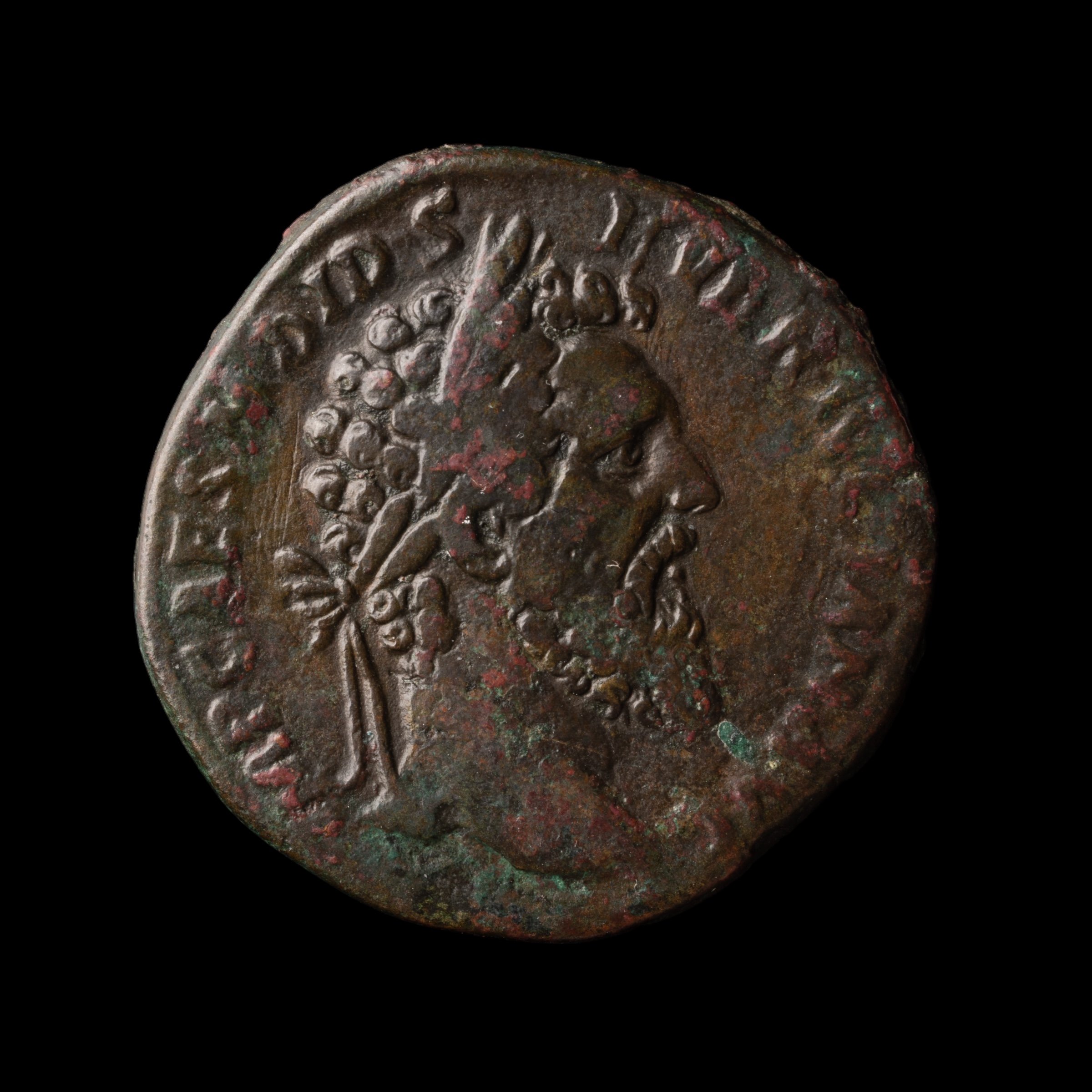 Image 1 of 2
Image 1 of 2

 Image 2 of 2
Image 2 of 2



Didius Julianus (193 AD): Ancient Roman Æ Sestertius from the Year of Five Emperors (about 1,830 years ago)
This bronze sestertius was struck in Rome in 193 AD, the same year Didius Julianus infamously bought the imperial throne in an open auction held by the Praetorian Guard. His reign lasted just 66 days before he was executed. Coins from his short-lived rule are rare and historically significant, offering a glimpse into one of the most chaotic and corrupt moments in Roman imperial history.
Front side:
Laureate head of Didius Julianus facing right
Aged features with a furrowed brow and tight lips reflect the emperor’s advanced age and tense grip on power
Inscription around the edge reads: IMP CAES M DID IVLIAN AVG
Back side:
Fortuna (or Concordia) standing left, holding cornucopia and rudder
Symbolizes an attempt to present stability and divine favor during political crisis
Reverse legend likely reads: FORT RED TR P COS or similar, referencing traditional Roman virtues
Technical Details:
Material composition: Bronze (Æ), with natural ancient patina
Denomination: Sestertius, approx. 28–32 mm diameter
Catalog/reference numbers: RIC IV 13; Cohen 13; BMCRE 24
Certification/grade: Not specified
Date/period of minting: Struck in 193 AD, Rome Mint
Historical Significance:
Didius Julianus is remembered as the emperor who purchased power—literally. After the assassination of Pertinax, the Praetorian Guard auctioned off the empire to the highest bidder. Julianus paid a vast sum to secure the title but failed to gain public or military support. His reign ended in less than 10 weeks. Coins from his rule are rare due to the short minting period and serve as tangible evidence of one of Rome’s most notorious political scandals. These coins mark the beginning of the civil wars that followed, eventually leading to the rise of Septimius Severus.
This bronze sestertius was struck in Rome in 193 AD, the same year Didius Julianus infamously bought the imperial throne in an open auction held by the Praetorian Guard. His reign lasted just 66 days before he was executed. Coins from his short-lived rule are rare and historically significant, offering a glimpse into one of the most chaotic and corrupt moments in Roman imperial history.
Front side:
Laureate head of Didius Julianus facing right
Aged features with a furrowed brow and tight lips reflect the emperor’s advanced age and tense grip on power
Inscription around the edge reads: IMP CAES M DID IVLIAN AVG
Back side:
Fortuna (or Concordia) standing left, holding cornucopia and rudder
Symbolizes an attempt to present stability and divine favor during political crisis
Reverse legend likely reads: FORT RED TR P COS or similar, referencing traditional Roman virtues
Technical Details:
Material composition: Bronze (Æ), with natural ancient patina
Denomination: Sestertius, approx. 28–32 mm diameter
Catalog/reference numbers: RIC IV 13; Cohen 13; BMCRE 24
Certification/grade: Not specified
Date/period of minting: Struck in 193 AD, Rome Mint
Historical Significance:
Didius Julianus is remembered as the emperor who purchased power—literally. After the assassination of Pertinax, the Praetorian Guard auctioned off the empire to the highest bidder. Julianus paid a vast sum to secure the title but failed to gain public or military support. His reign ended in less than 10 weeks. Coins from his rule are rare due to the short minting period and serve as tangible evidence of one of Rome’s most notorious political scandals. These coins mark the beginning of the civil wars that followed, eventually leading to the rise of Septimius Severus.
This bronze sestertius was struck in Rome in 193 AD, the same year Didius Julianus infamously bought the imperial throne in an open auction held by the Praetorian Guard. His reign lasted just 66 days before he was executed. Coins from his short-lived rule are rare and historically significant, offering a glimpse into one of the most chaotic and corrupt moments in Roman imperial history.
Front side:
Laureate head of Didius Julianus facing right
Aged features with a furrowed brow and tight lips reflect the emperor’s advanced age and tense grip on power
Inscription around the edge reads: IMP CAES M DID IVLIAN AVG
Back side:
Fortuna (or Concordia) standing left, holding cornucopia and rudder
Symbolizes an attempt to present stability and divine favor during political crisis
Reverse legend likely reads: FORT RED TR P COS or similar, referencing traditional Roman virtues
Technical Details:
Material composition: Bronze (Æ), with natural ancient patina
Denomination: Sestertius, approx. 28–32 mm diameter
Catalog/reference numbers: RIC IV 13; Cohen 13; BMCRE 24
Certification/grade: Not specified
Date/period of minting: Struck in 193 AD, Rome Mint
Historical Significance:
Didius Julianus is remembered as the emperor who purchased power—literally. After the assassination of Pertinax, the Praetorian Guard auctioned off the empire to the highest bidder. Julianus paid a vast sum to secure the title but failed to gain public or military support. His reign ended in less than 10 weeks. Coins from his rule are rare due to the short minting period and serve as tangible evidence of one of Rome’s most notorious political scandals. These coins mark the beginning of the civil wars that followed, eventually leading to the rise of Septimius Severus.





















